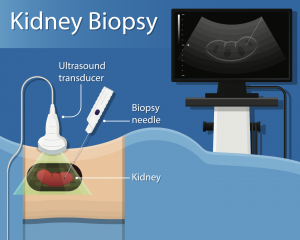Responsum for CKD
{{user.displayName ? user.displayName : user.userName}}
{{ user.userType }}

Kidney Health Australia
Seeking to improve the patient and caregiver experience for renal biopsies, an Australian nonprofit turns to breast, liver, and prostate biopsy studies for data with which to enhance communication between patients and their care teams.
A biopsy—the surgical extraction and examination of a living tissue sample to determine the presence, cause, or extent of a disease—can be scary and sometimes painful. How healthcare staff approach patient education and communication before, during, and after the procedure can make a huge impact on the overall experience for both patients and their caregivers.
Few studies have been done to gauge patient and caregiver experiences when it comes to renal biopsy. There are studies, however, concerning other types of biopsies that can inform medical teams’ approaches and suggest further research concerning communication, patient education, psychosocial support, and self-management.
A non-profit organization, Kidney Health Australia, shares an overview of the studies on which they based their guidelines for best practices on biopsy information and education for patients and caregivers.*
Percutaneous renal biopsy—or the extraction of a tissue sample from the kidney via needle—is considered the most reliable way to explore the causes of kidney disease.
A renal biopsy is a day-long process that consists of three main steps:

The research team used multiple studies to acquire data about biopsy information and education for patients and caregivers. Of the studies used, two studies involved prostate biopsies, and seven studies involved breast biopsies.
In the studies where men had undergone transrectal prostate biopsies, they found the following information:
In the first study, which surveyed 85 men:
In the second study, which included 30 men:
Data gleaned from the seven breast biopsy studies demonstrated that the participants:
Moreover, caregivers desired more information about the procedure, diagnosis, treatment options, and side effects.
Upon analyzing these biopsy studies, the researchers gained significant insight from one study in particular, which offered possible modeling for best practices. The study surveyed women, ranging in age from 24 to 92, who had undergone breast biopsies in a rural cancer center that focuses on effective patient communication and education.
The study showed that the center:
More than 95% of the women surveyed agreed that:
Biopsies can be extremely stressful, given their potentially life-altering results. The evidence suggests that many patients’ psychosocial needs are not being adequately addressed in a widespread, compassionate, constructive way before, during, or after these procedures.
The study demonstrates a need for medical professionals and researchers to reevaluate their patient protocols and adapt the suggestions to renal biopsies while continuing to improve the patient and caregiver experience.
*Champion de Crespigny, P., See, E., Lopez-Vargas, P., et al. (2018, July.). “Biopsy Information and Education for Patients and Caregivers.” Kidney Health Australia.
Source: {{articlecontent.article.sourceName}}
Receive daily updated expert-reviewed article summaries. Everything you need to know from discoveries, treatments, and living tips!
Already a Responsum member?
Available for Apple iOS and Android
Add Comments
Cancel